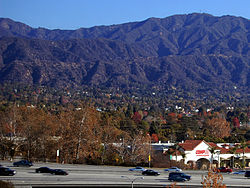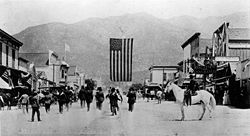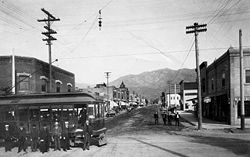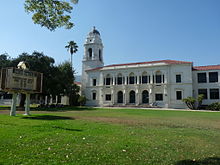- Monrovia, California
-
City of Monrovia — City — I210 in Monrovia with San Gabriel Mountains in the background. Location of Monrovia in Los Angeles County, California. Coordinates: 34°8′39″N 118°0′7″W / 34.14417°N 118.00194°WCoordinates: 34°8′39″N 118°0′7″W / 34.14417°N 118.00194°W Country United States State California County Los Angeles Government - City council Mayor Mary Ann Lutz
Mayor Pro Tem Tom Adams
Tom Adams
Dan Kirby
Joe Garcia- City Treasurer Stephen Baker[1] Area[2] - Total 13.714 sq mi (35.519 km2) - Land 13.605 sq mi (35.237 km2) - Water 0.109 sq mi (0.282 km2) 0.79% Elevation 571 ft (174 m) Population (2010) - Total 36,590 - Density 2,668.1/sq mi (1,030.2/km2) Time zone PST (UTC-8) - Summer (DST) PDT (UTC-7) ZIP codes 91016, 91017 Area code(s) 626 FIPS code 06-48648 GNIS feature ID 1661049 Website ci.monrovia.ca.us Monrovia is a city located in the foothills of the San Gabriel Mountains in the San Gabriel Valley of Los Angeles County, California, United States. The population was 36,590 at the 2010 census, down from 36,929 at the 2000 census. Monrovia has been used extensively for filming many TV shows, movies and commercials.
Contents
History
Monrovia is the fourth oldest general law city in Los Angeles County and the L.A. Basin (after Los Angeles, Santa Monica, and Pasadena). Incorporated in 1887, Monrovia has grown from a sparse community of orange ranches to a residential community of 37,000.
Around 500 BC, a band of Shoshonean-speaking Indians established settlements in what is now the San Gabriel Valley. These native Americans came to be called the Gabrieliño Indians by early Spanish explorers, and are now referred to as the Tongva. The Tongva were not farmers; they gathered wild seeds, berries, and plants along rivers and in marshlands. Abundant oaks in the Valley, such as Coast Live Oak and Interior Live Oak provided a staple of the Tongva diet: acorn mush made of boiled acorn flour.
In 1769, when all California was claimed by the King of Spain, Europeans first visited the San Gabriel Valley, including Monrovia. An expedition from San Diego passed through en route to Monterey Bay, commanded by Don Gaspar Portola. Accompanying Portola were a Franciscan Father from Father Junipero Serra's Franciscan order of Mexico, and Juan Crespi, the expedition's diarist. Much of what is known of early California is known only from Crespi's detailed descriptions.
In 1771, the Franciscans established the Mission San Gabriel Arcangel in the San Gabriel Valley. The mission was a resting point for early California travelers and gathered most of the native Tongva into an agricultural lifestyle. Following the Mexican Revolution in 1839, the mission lands were nationalized.
In 1841, California Governor Juan Alvarado gave Rancho Azusa de Duarte to Andres Duarte, a Mexican soldier, and he gave Rancho Santa Anita to Hugo Reid, a naturalized Mexican citizen of Scottish birth. Monrovia is made of parts of these two ranchos.
In the mid-19th century, most of Rancho Azusa de Duarte was subdivided and sold by Duarte to settle his debts. Some of those parcels would eventually end up as part of the ranch of William N. Monroe, Monrovia's namesake.
Rancho Santa Anita changed hands several times before the famous multimillionaire, silver baron and rancher, E.J. "Lucky" Baldwin acquired it in 1875. That same year his Los Angeles Investment Company began subdividing and selling parcels from many of his ranchos. In 1883, 240 acres (970,000 m²) of Rancho Santa Anita were sold to Monroe for $30,000. Additional parcels of Rancho Santa Anita were sold to Edward F. Spence, John D. Bicknell, James F. Crank, and J.F. Falvey.
The completion of the Santa Fe (which would run through Monrovia) and Southern Pacific railroads to Southern California would bring new people looking for homes and investment opportunities. With this in mind, Monroe, Spence, Bicknell, Crank, and Falvey decided to combine their land under the business name of the Monrovia Land and Water Company in 1886. The combined lots formed the Town of Monrovia Subdivision. The original borders of the Town of Monrovia Subdivision were Canyon Blvd. to the east, Walnut Ave. to the south, Magnolia Ave. to the west, and Lime Ave. to the north. The subdivision was then itself quickly subdivided into 600 500-foot (150 m) by 160-foot (49 m) lots and sold. Some lucky buyers of these lots turned around and sold them very quickly. Those who chose to hold on to their property saw its value fall to a fraction of its 1886-1887 value.
The town was incorporated in 1887 under the leadership of prohibitionists who wished to control the arrival of an unwelcome saloon. The first order of business for the newly formed government was to pass a tippler's law, prohibiting the sale of alcohol.
In 1903 the Monrovia News was established. In the same year, the Pacific Electric was opened providing transportation to and from Los Angeles, making it possible for Monrovian homeowners to work in Los Angeles.
In 1905 Carnegie funds became available and with the help of the Board of Trade (forerunner to the Chamber of Commerce), and the Monrovia Women's Club, a bond issue was passed to purchase the Granite Bank Building to be used as a City Hall, and to acquire property for a public park. The Granite Building serves as the city hall, fire and police department facilities in 1961 and the fire department in 1974. In 1956, the old Carnegie library building was torn down and the present library constructed. The library now boasts a book collection of 95,000 volumes.As of March 2007, the city's residents were asked to vote on a new, upgraded library which is ADA-compliant and has twice as much room for books and computer usage as the current one(the measure passed with at least 70% of the vote.).
A city council-manager type government was instituted in 1923.
In 1937, Patrick McDonald opened a simple restaurant on Huntington Drive (Route 66) near the old Monrovia Airport called "The Airdrome" (hamburgers were ten cents, and all-you-can-drink orange juice was five cents); the restaurant remained there until 1940, when he and his two sons, Maurice and Richard, moved the entire building 40 miles (64 km) east to San Bernardino to the corner of West 14th Street and 1398 North E Street renaming it "McDonald's". In 1955, milkshake machine salesman Ray Kroc made a franchising deal with the McDonald brothers. In 1961 Kroc purchased the business rights for $2.7 million. For years after the McDonald's Corporation claimed the 1955 Des Plaines, Illinois Mcdonald's to be the first (it was the first location franchised through Ray Kroc), and only recently has recognized San Bernardino. Some though claim Monrovia to be the "real" birthplace, but that's subjective since McDonald's as it was first franchised in 1953 (in Phoenix, Arizona and Downey, California) came into being following the development of the "Speedee Service System" in 1948.
The Upton Sinclair House, home to activist and author Upton Sinclair, is located in Monrovia and is a National Historic Landmark. In 1995 Monrovia received the All America City Award from the National Civic League.
Monrovia operates its own Fire & Police Departments led by Fire Chief Christopher Donovan and Chief of Police Roger W. Johnson
Geography
According to the United States Census Bureau, the city has a total area of 35.5 square kilometers (13.7 sq mi). 13.6 square miles (35 km2) of it is land and 0.1 square miles (0.26 km2) of it (0.79%) is water.
Demographics
2010
The 2010 United States Census[3] reported that Monrovia had a population of 36,590. The population density was 2,668.1 people per square mile (1,030.2/km²). The racial makeup of Monrovia was 21,932 (59.9%) White, 4,107 (11.2%) Asian, 2,500 (6.8%) African American, 279 (0.8%) Native American, 76 (0.2%) Pacific Islander, 5,818 (15.9%) from other races, and 1,878 (5.1%) from two or more races. Hispanic or Latino of any race were 14,043 persons (38.4%).
The Census reported that 36,434 people (99.6% of the population) lived in households, 61 (0.2%) lived in non-institutionalized group quarters, and 95 (0.3%) were institutionalized.
There were 13,762 households, out of which 4,725 (34.3%) had children under the age of 18 living in them, 6,295 (45.7%) were opposite-sex married couples living together, 2,073 (15.1%) had a female householder with no husband present, 778 (5.7%) had a male householder with no wife present. There were 793 (5.8%) unmarried opposite-sex partnerships, and 131 (1.0%) same-sex married couples or partnerships. 3,649 households (26.5%) were made up of individuals and 1,276 (9.3%) had someone living alone who was 65 years of age or older. The average household size was 2.65. There were 9,146 families (66.5% of all households); the average family size was 3.24.
The population was spread out with 8,514 people (23.3%) under the age of 18, 3,084 people (8.4%) aged 18 to 24, 10,733 people (29.3%) aged 25 to 44, 10,018 people (27.4%) aged 45 to 64, and 4,241 people (11.6%) who were 65 years of age or older. The median age was 37.9 years. For every 100 females there were 91.6 males. For every 100 females age 18 and over, there were 87.0 males.
There were 14,473 housing units at an average density of 1,055.4 per square mile (407.5/km²), of which 6,809 (49.5%) were owner-occupied, and 6,953 (50.5%) were occupied by renters. The homeowner vacancy rate was 1.3%; the rental vacancy rate was 4.9%. 18,478 people (50.5% of the population) lived in owner-occupied housing units and 17,956 people (49.1%) lived in rental housing units.
2000
As of the census[4] of 2000, there were 36,929 people, 13,502 households, and 9,086 families residing in the city. The population density was 2,686.5 inhabitants per square mile (1,037.0/km²). There were 13,957 housing units at an average density of 1,015.3 per square mile (391.9/km²). The racial makeup of the city was 62.92% White, 8.67% African American, 7.02% Asian, 0.87% Native American, 0.13% Pacific Islander, 15.61% from other races, and 4.77% from two or more races. Hispanic or Latino of any race were 35.24% of the population.
There were 13,502 households out of which 35.4% had children under the age of 18 living with them, 46.4% were married couples living together, 15.4% had a female householder with no husband present, and 32.7% were non-families. 26.0% of all households were made up of individuals and 8.8% had someone living alone who was 65 years of age or older. The average household size was 2.71 and the average family size was 3.29.
In the city the population was spread out with 27.4% under the age of 18, 8.0% from 18 to 24, 34.0% from 25 to 44, 20.2% from 45 to 64, and 10.4% who were 65 years of age or older. The median age was 34 years. For every 100 females there were 92.2 males. For every 100 females age 18 and over, there were 87.6 males.
The median income for a household in the city was $45,375, and the median income for a family was $49,703. Males had a median income of $41,039 versus $32,259 for females. The per capita income for the city was $21,686. About 9.7% of families and 13.1% of the population were below the poverty line, including 18.3% of those under age 18 and 9.7% of those age 65 or over.
Government and infrastructure
In the state legislature Monrovia is located in the 29th Senate District, represented by Republican Bob Huff, and in the 44th and 59th Assembly Districts, represented by Democrat Anthony J. Portantino and Republican Tim Donnelly respectively. Federally, Monrovia is located in California's 26th congressional district, which has a Cook PVI of R +4[5] and is represented by Republican David Dreier.
The Los Angeles County Department of Health Services operates the Monrovia Health Center in Monrovia.[6]
Education
Monrovia Unified School District operates public schools.
Monrovia High School gained a creditable rating in its early history. The first school in Monrovia was built in 1887. It was located where Monroe School now stands, and housed the entire elementary and high school student body. A new high school on the property now occupied by Clifton Middle School was erected in 1905, and in 1912 was greatly expanded by the addition of new buildings. In 1928 a high school to serve the communities of Monrovia, Arcadia and Duarte was built. The same structure now serves only Monrovia students, as the elementary and high school district were unified into one district in 1961. The district now has one high school, one continuation school, two middle schools and five elementary schools, and is part of the Citrus Community College District. There are also three parochial schools in Monrovia.
Monrovia, California's schools are:
- Bradoaks Elementary School, K-5, 930 E. Lemon
- Calvary Road Baptist Academy, K-12, 319 W. Olive
- Canyon Early Learning Center, public pre-K, 1000 South Canyon
- Canyon Oaks High School (public alternative), 7-12, 930 Royal Oaks Drive
- Carden of the Foothills, K-8, 429 Wild Rose
- Church of the Nazarene, K-6 303 W. Colorado
- Clifton Middle School, 6-8, 226 S. Ivy
- First Lutheran School, pre-K-8, 1323 South Magnolia
- First Presbyterian Church Preschool, 101 E. Foothill Blvd.
- Immaculate Conception School, K-8, 726 Shamrock
- Joe Ferrante Music Academy, K-12, 126 E. Colorado Blvd.
- Mayflower Elementary School, K-5, 210 North Mayflower
- Monroe Elementary School, K-5, 402 W. Colorado
- Monrovia Community Adult School] 920 South Mountain
- Monrovia High School 9-12, 845 W. Colorado Boulevard
- Monrovia Mountain School, public Alternative K-8, 950 S. Mountain Avenue
- Mt. Sierra College Trade College
- Plymouth Elementary K-5, 1300 Boley Street
- Santa Fe Middle School 6-8, 148 W. Duarte Road
- Serendipity Early Care and Education Center, K, 940 W. Duarte Road
- Wild Rose Elementary, A California Distinguished School K-5, 232 Jasmine
- Vista Ridge Academy, 1311S. Shamrock
Monrovia Public Library is located at Library Park, at the corner Myrtle Avenue and Lime Avenue.
Transportation
Monrovia has several main roads, including Foothill Boulevard and Huntington Drive (historic Route 66). It is also served by the Foothill Freeway (I-210).
In 2014, Metro will open a new light-rail station in Monrovia. Monrovia Station will be located at the intersection of Myrtle Avenue and Duarte Road, and will be served by the Metro Gold Line.[7] It will be at the same location of the former Santa Fe Railway depot, which still stands.
Economy
Original Tommy's, Trader Joe's, Green Dot and Naked Juice are based in Monrovia.
Top employers
According to the City's 2010 Comprehensive Annual Financial Report,[8] the top employers in the city are:
# Employer # of Employees 1 Monrovia Unified School District 488 2 Ducommun AeroStructures 463 3 WorleyParsons 452 4 The Home Depot 364 5 Oracle 315 6 AeroVironment 267 7 Vinyl Technology 251 8 City of Hope 250 9 ITT Systems 240 10 City of Monrovia 240 Trivia
The House to the 1986 horror-comedy cult film House (1986 film) is located at 329 Melrose Avenue in Monrovia.[9]
Notable residents
- Kenny Baker, singer and actor
- Dicky Barrett, frontman, Mighty Mighty Bosstones, late night TV announcer
- Ron Brown, actor
- Mary Ford, vocalist and guitarist
- Jim Fuller, guitarist for The Surfaris (of "Wipeout" fame)
- Prince Gomolvilas, playwright
- Dean R. Hirsch, president of World Vision International
- Corky King, founder of Summum
- Scott Land, puppeteer/actor
- Francis M. Pottenger, Jr., nutrition researcher
- Upton Sinclair and Mary Craig Sinclair, authors and producers
- Jacob Smith, actor
- William A. Spinks (1865–1933), champion carom billiards pro, co-inventor of modern billiards cue chalk, oil investor, and flower and avocado farmer (developer of the Spinks avocado cultivar); also maintained a home and farm in nearby Duarte
- The Fabulous Wonder Twins, entertainers
- Jason Earles, actor, Hannah Montana
- Bill Cormalis, visual artist
- Michael Lee, keyboardist for Meredith Brooks and Melissa Etheridge
References
- ^ California League of Cities, Elected City Treasurers
- ^ U.S. Census
- ^ All data are derived from the United States Census Bureau reports from the 2010 United States Census, and are accessible on-line here. The data on unmarried partnerships and same-sex married couples are from the Census report DEC_10_SF1_PCT15. All other housing and population data are from Census report DEC_10_DP_DPDP1. Both reports are viewable online or downloadable in a zip file containing a comma-delimited data file. The area data, from which densities are calculated, are available on-line here. Percentage totals may not add to 100% due to rounding. The Census Bureau defines families as a household containing one or more people related to the householder by birth, opposite-sex marriage, or adoption. People living in group quarters are tabulated by the Census Bureau as neither owners nor renters. For further details, see the text files accompanying the data files containing the Census reports mentioned above.
- ^ "American FactFinder". United States Census Bureau. http://factfinder.census.gov. Retrieved 2008-01-31.
- ^ "Will Gerrymandered Districts Stem the Wave of Voter Unrest?". Campaign Legal Center Blog. http://www.clcblog.org/blog_item-85.html. Retrieved 2008-02-10.
- ^ "Monrovia Health Center." Los Angeles County Department of Health Services. Retrieved on March 27, 2010.
- ^ http://www.foothillextension.org/city_monrovia.html
- ^ City of Monrovia CAFR
- ^ http://www.movie-locations.com/movies/h/House.html
External links
Greater Los Angeles Area Central city Counties Satellite cities Cities
>200kCities and towns
100k–200kBurbank • Compton • Corona • Costa Mesa • Downey • East Los Angeles • El Monte • Fontana • Fullerton • Garden Grove • Inglewood • Lancaster • Mission Viejo • Moreno Valley • Murrieta • Norwalk • Ontario • Orange • Palmdale • Pasadena • Pomona • Rancho Cucamonga • Santa Clarita • Simi Valley • South Gate • Temecula • Thousand Oaks • Torrance • Ventura • Victorville • West CovinaArea regions Antelope Valley • Conejo Valley • Downtown Los Angeles • East Los Angeles • Gateway Cities • Greater Hollywood • Harbor Area • Inland Empire • Palos Verdes Hills • Pomona Valley • San Bernardino Valley • San Fernando Valley • San Gabriel Valley • Santa Ana Valley • Santa Clarita Valley • South Bay • South Los Angeles • Westside Los AngelesLandforms Los Angeles Basin • Baldwin Hills (range) • Calico Mountains • Catalina Island • Channel Islands • Coachella Valley • High Desert—Mojave Desert • Low Desert—Colorado Desert • San Fernando Valley • San Bernardino Mountains • San Gabriel Mountains • Santa Ana Mountains • Santa Monica Mountains • Santa Susana Mountains • Verdugo MountainsBodies of water Los Angeles River • Aliso Creek • Arroyo Seco • Ballona Creek • Bell Creek • Big Bear Lake • Coyote Creek • Lake Arrowhead • Lake Perris • Lake Piru • Malibu Creek • Pacific Ocean • Pyramid Lake • Rio Hondo • San Gabriel River • San Juan Creek • San Pedro Bay • Santa Ana River • Santa Clara River • Santa Margarita River • Santa Monica BayCategories:- Communities in the San Gabriel Valley
- Cities in Los Angeles County, California
- Communities on U.S. Route 66
- Incorporated cities and towns in California
- Populated places established in 1887
Wikimedia Foundation. 2010.










